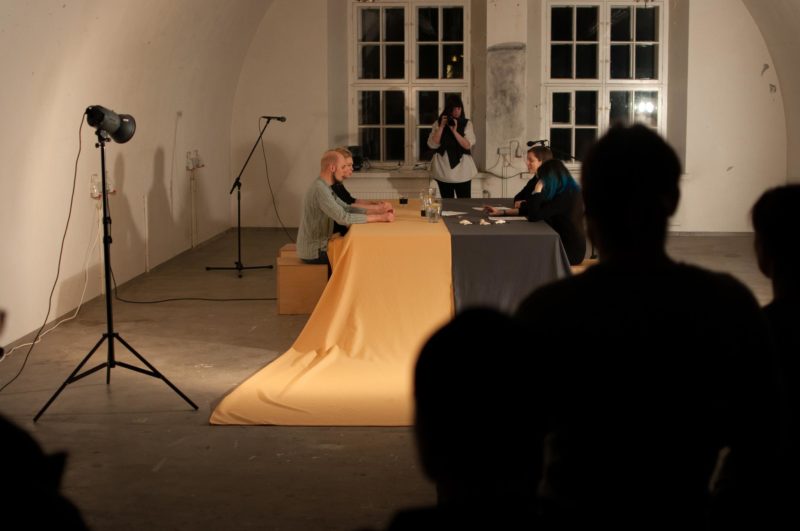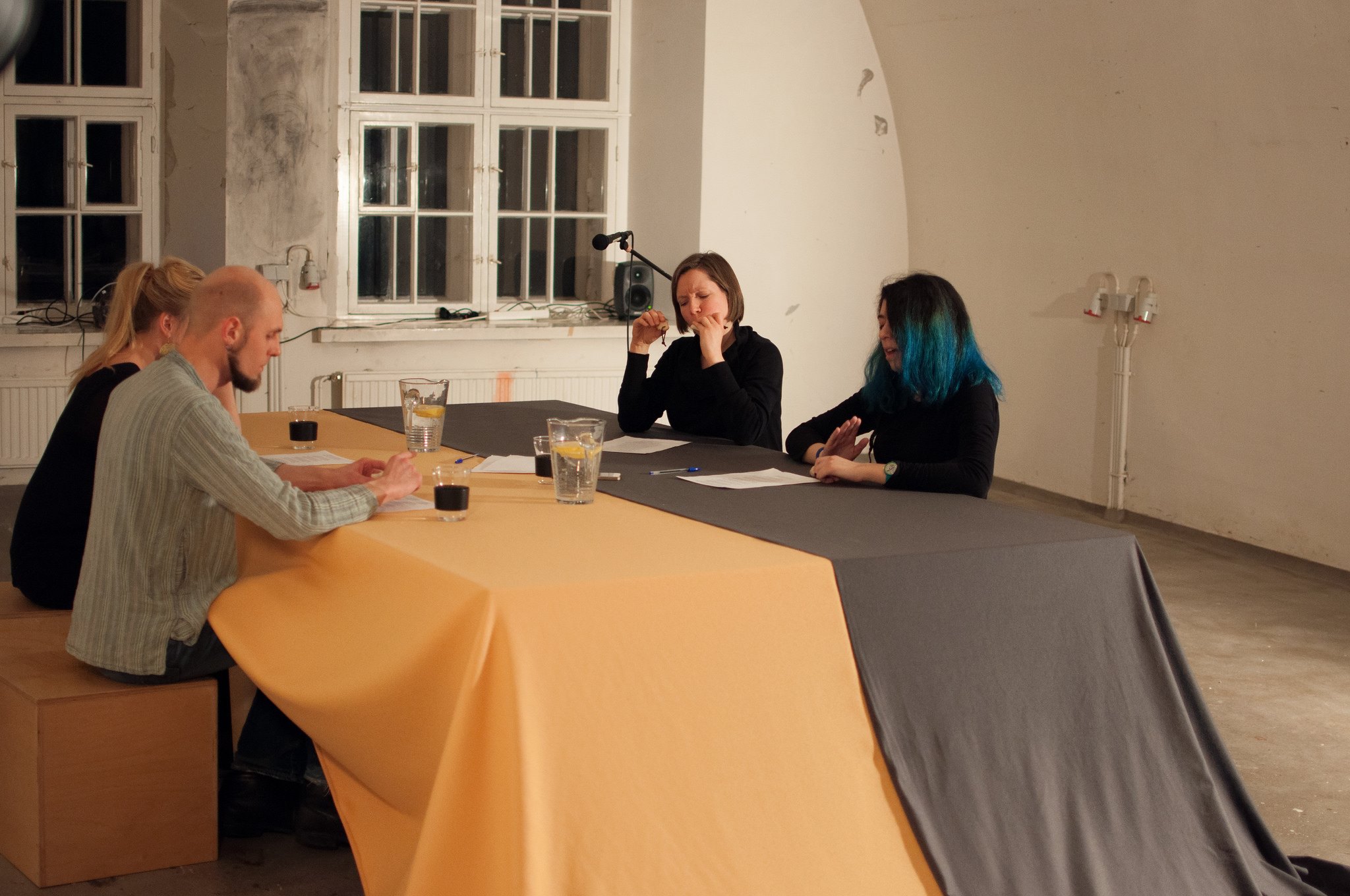29 Feb 2016
Interview
Anna Moreno: The Whole World Will Be Singing

Anna Moreno’s piece about an artist’s journey in time.
IN PRIMEVAL TIMES, AN ARTIST MOTHER
DARKEST WIDOW OF THE VERMILLION SANDS
ERECTED A SONIC SCULPTURE WITH CHROMIUM STRUTS
A METALLIC HOMAGE TO HER DEAD LOVER
In a dark space, four people are sitting around a big wooden table. The table is covered with a two-tone cloth that runs over it and across the floor. The four people are chattering, reading a sheet of paper that has been placed in front of them. Suddenly, they start singing. Cameras record their every word.
The artist, Anna Moreno, tells me that the table is a brasero; a traditional Spanish table with a heater placed underneath. The artist had it made in the Finnish city of Lahti, while resident at HIAP in Suomenlinna. A piece of Spain, made by Finnish artisans, using Finnish wood. On the table, there are also a few bird whistles, which the artist Anna Moreno sees as being seductive, also made here in Finland. The singers are folk singers, one of them Italian, the rest are Finnish. The project is international not only through it’s participants, but through the artist herself as well as her table. Moreno is from Spain, but currently resides in the Netherlands. The table will travel from Helsinki to Barcelona, once Moreno will complete her HIAP residency. Moreno does not want her work to be seen as site-specific, however. It just so happens that every part of her piece has developed out of a negotiation or friendship with the local community.
The singers discuss the text in front of them, while warming up around the brasero; what does the text mean, how do they relate to it, how does it transform itself to melody. It becomes clear that they have a task; to create a song out of a text they have never seen before. The audience of around fifty people does not get a finished song, a ready melody, but instead a process, a discussion, a negotiation.
The process is indeed important, as is tradition. The slow paced discussion pays due respects to tradition, craftmanship, local materials. The core point of the piece is, however, negotiation; four strangers coming together to create a single work of art. It is not an easy task for them; the text itself presents challenges, as it is written in English, not the singers’ first language. It tells the retrofuturistic, almost science fiction story of the creation of a world as a foundational myth, combining the past, the present and the future; definitely tricky to decipher in just over an hour.
The music the singers end up creating though improvisation sounds almost religious with its drumming and steady rhythm. At first, the singers appear nervous and timid. Slowly they open up and start making all sorts of noises, throat singing, rhythmic clapping and animal sounds. It seems as if they occasionally forget the text, forget what they are trying to do.
LONGLY HAD THE PEOPLE ABOUT HER FORGOTTEN
WHEN THE CITY’S FOUNDATIONS BEGAN PULSING
A MONOTONOUS DRUM, A HIGH-PITCHED WAILING
WAS THE FAMILIAR CHANT OF THE MURDERED DAUGHTER
The audience is intrigued; some laugh, some dance. However, most do not have the energy to watch the entire performance. A group of a dedicated few (maybe around 15 people) watch the process from the beginning to the end. The performance was supposed to last one hour, but goes over the arranged time slot by another. Occasionally the shaman-like, meditative atmosphere gets interrupted by people entering or leaving the room, and also the group’s discussion. It would seem that wrapping things up is the hardest part of the performance for them. They work wonderfully as a group while improvising, but finalising the song is a little trickier. Maybe the singers could have just used a little more time.
Eventually, more than an hour after the original closing time, the singers are ready. A three-part song based on the text The Whole Word Was Singing is ready to be performed to the audience for the first time. The first part of the piece reminds me of the well-known ballad of Scarborough Fair; a calm introduction to the story. The second part is much more rhythmic and occasionally even aggressive; the words pulsing, murder, drum, and daughter get repeated, reminding me of the band Liars and their vicious repetition of the word blood. The third part sounds the most traditional, almost religious, and also somewhat like a lullaby. Soothing vibrations, they sing, and that is exactly what they are.
Moreno has based her performative piece and the text that forms its core on a bizarre theory; according to Moreno, the artist travels in time and her imagination of the future depends on present developments. In Moreno’s view, there have been three pivotal moments in recent history: the very beginning of the 20th century, which Moreno sees as the era of progressive thinking, the 1930s with bauhaus and functionalism, and the 70s, with their sci-fi and dystopian literature. These three moments in time are of extreme importance to Moreno. Through these moments, her imaginary artist/hero views the present from the future. To concretely tie the theory in with the piece, she intends to make two more tables; three negotiation tables, for three moments in 20th century. This science fiction theory manifests itself in the text, which bases itself on foundational myths such as the Kalevala, oddly shaped and twisted by our present.
SOON, THE WHOLE WORLD WAS SINGING
THE WHOLE WORLD WAS SINGING
THE WHOLE WORLD WAS SINGING

Anna Moreno’s residency at HIAP has been supported by Stroom Den Haag.
Text by Tessa Aarniosuo.
Photos by Salla Lahtinen / HIAP.
